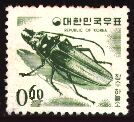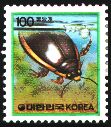 Insect Stamp of Republic of Korea
Insect Stamp of Republic of Korea Insect Stamp of Republic of Korea
Insect Stamp of Republic of KoreaThe Korean Peninsura was unified by Koma in Silla, the tenth century in the seventh century, and Li-regimed Korea was formed in the 14th century. I entered an influence bottom of China / Kiyoshi afterward, but it was demanded the foundation of a country from Japan in 1876 by military power and concluded a rouge sinter island treaty, and Japanese, it was merged in 1910. Large-scale independence movement happens in March, 1919 and achieved independence in August, 1945, but, in the south, the Republic of Korea, the north are born at lat. 38 degrees N as the Democratic People's Republic of Korea (North Korea) in a boundary line in 1948 because it was divided in the north and south by both U.S. and Russia armed forces stationed in the Korean Peninsura. Korean War breaks out by invasion of Northern forces planning military unification in 1950, and truce mediation was concluded in 1953, but structure of north and south opposition reaches it at the present. It established diplomatic relations in China in 1990 and former Soviet Union in 1992.
The thing describing the honeybee is published as a South Korean juvenile storage encouragement stamp in 1960.
The normal stamp describing large-sized Asian Callipogon Longhorn Beetle was issued in 1966. Although it is monochrome, Asian Callipogon Longhorn Beetle of a rare variety is a subject matter and is one of the favorite stamps. Three kinds of insect stamps were issued with the small sheet by the same year.
the honeybee stamp was issued in 1974. Eight kinds of butterfly stamps were issued in 1976.
Ten kinds of normal stamps altogether unified with the familiar insect were issued in 1991. Although Printing side is small, the insect is drawn ecologically and it is palatable.
Republic of Korea
| 1960.4.1 juvenile storage encouragement stamp | 1966.8.20 Normal Stamp |
 |
 |
|---|---|
| Western Honeybee Apis mellifera (Apidae) |
Asian Callipogon Longhorn Beetle Callipogon relictus (Cerambycidae) |
1966.9.15 Normal Stamp
 |
 |
 |
|---|---|---|
| Heike Firefly Luciola lateralis (Lampyridae) |
Katydid Hexacentrus japonicus (Tettigoniidae) |
Narrow Swallowtail Sericinus telamon (Papilionidae) |
1974.1.20 Normal Stamp
 |
|---|
| Western Honeybee Apis mellifera (Apidae) |
1976.1.20/1976.3.20 Butterfly Stamp
 |
 |
 |
 |
|---|---|---|---|
| Window Emperor Dilipa fenestra (Nymphalidae) |
Princess Gifu Butterfly Luehdorfia puziloi (Papilionidae) |
Asian Swallowtail Papilio xuthus (Papilionidae) |
High Altitude Butterfly Parnassius bremeri (Papilionidae) |
 |
 |
 |
 |
|---|---|---|---|
| Eastern Pale Clouded yellow Colias erate (Pieridae) |
Chinese Windmill Atrophaneura alcinous (Papilionidae) |
Red Ring Skirt Hestina assimilis (Nymphalidae) |
Common Bluebottle Graphium sarpedon (Papilionidae) |
1991.4.8 Normal Stamp
 |
 |
 |
 |
 |
|---|---|---|---|---|
| Carpenter Bee Appendiculata circumvolans (Anthophoridae) |
Burnet Moth Mimeusemia perilmilis (Agaristidae) |
Longhorn Beetle Polyzonus fasciatus (Cerambycidae) |
Scolyrnus Orange-tip Anthocharis scolymus (Pieridae) |
Tiger Beetle Cicindela chinensis (Cicindelidae) |
 |
 |
 |
 |
 |
|---|---|---|---|---|
| Seven-spotted Ladybird Coccinella septempunctata (Coccinelidae) |
Great Diving Beetle Cybister japonicus (Dytiscidae) |
Lesser Emperor Anax parthenope (Aeschnidae) |
Katydid Gampsocleis sedakovi (Tettigoniidae) |
Cicada Suisha coreana (Cicadidae) |
Callipogon relictus is called Callipogon and its greatest Callipogon almitaras (male length of about 11cm) is in a friend in Longhorn beetle. Although it was the kind it was presupposed that was lived only in the valley in the South America Amazon River, kind discovery was carried out from the Usury district in Far East Russia the front for about 70 years, and sensation was created in academic circles. This is Callipogon relictus. Argument sprang among scholars why it would be distributed over the remote place beyond the Pacific Ocean. However, it seems that it is appropriate like Stag beetle to consider the preexisted type of old days. That is, the friend of Callipogon relictus also was widely distributed over the Eurasian Continent or the U.S. continent, and he was prosperous. However, according to some factors, probably several kinds were exterminated and only Callipogon relictus remained at last in Asia.
 NEXT
NEXT
 to Stamp
to Stamp
 to HomePage
to HomePage